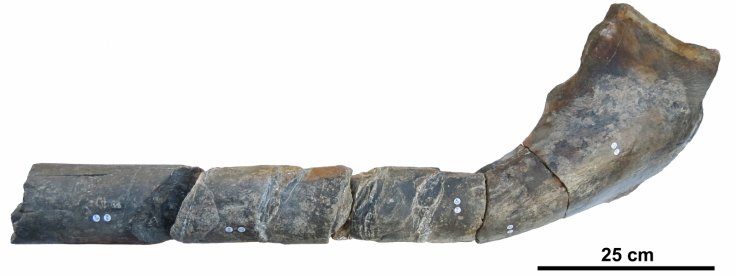
A prehistoric reptile bone was found on England's beach and experts claim that this 205-million-year-old creature was one of the largest animals living on our planet.
The last known ichthyosaur bones were found in Scotland's Isle of Skye, also called the Storr Locks Monster, measured 13-foot-long and believed to have existed about 170 million years ago.
Last year, the most intact bones were found in Gujarat, India called Lodai ichthyosaur, estimated to have lurked the ocean some 150 million years ago.
The latest jaw bone of the giant Ichthyosaur was, found by accident on the English beach and was sent for analysis, where they concluded that it measured a whopping 26 meters long, similar to the size of some blue whale, the largest known animal ever lived on this planet.
The study was published in the journal PLOS One, after the giant fossil was discovered by collector Paul de la Salle in May 2016 on the coast of Lilstock, Somerset. Paul is also the co-author of the study, which is based on the details of the fossil.
Paul said in a statement that when he found the fossil it looked like a piece of rock but after he recognized the groove and bone structure, he thought that it might be a part of Ichthyosaur's jaw. When Paul discovered that, it was actually a giant fossil, he contacted Ichthyosaur experts Dean Lomax from the University of Manchester and Judy Massare from the State University of New York College at Brockport, who expressed interest in studying the specimen.
Prio to this discovery, the largest known Ichthyosaur specimen was the one kept at Royal Tyrrell Museum of Palaeontology in Alberta, Canada. When the experts analyzed the recent bone fossil, they concluded that it was, indeed, an incomplete section of a large Ichthyosaur specimen's jaw part. Then Massare and Lomax compared it to the previous largest Ichthyosaur specimen.

Massare told Newsweek that they compared the "jawbone to that of Shonisaurus sikanniensis, the largest Ichthyosaur previously known, with an estimated length of up to 21 meters. Our bone was about 25 percent deeper. The estimate assumes that the two animals had a similar shape for this bone, as neither specimen preserves the entire bone."
Lomax said that since the new specimen is only represented by a piece of jaw, it is difficult to estimate the size of the creature. But by using the scaling factor, the researcher stated that the Lilstock specimen could be about 25 percent larger.
Other comparisons showed that the "Lilstock Ichthyosaur was at least 20-25 meters (67-82 feet). Of course, such estimates are not entirely realistic because of differences between species. Nonetheless, simple scaling is commonly used to estimate size, especially when the comparative material is scarce," he explained.
Massare suggested that the bone from fragments found in 1850 in the nearby village of Aust, Gloucestershire, are "from the jaw of an ichthyosaur even larger than the one we described. However, the Aust specimen is so fragmentary that a length estimate is not possible."
However, Ichthyosaur was one of the largest marine creatures that used to live in the deep ocean during the age of the dinosaurs, whose species started fading away from the earth due to consumption of a poisonous flower, even before the asteroid that hit earth millions of years ago.









